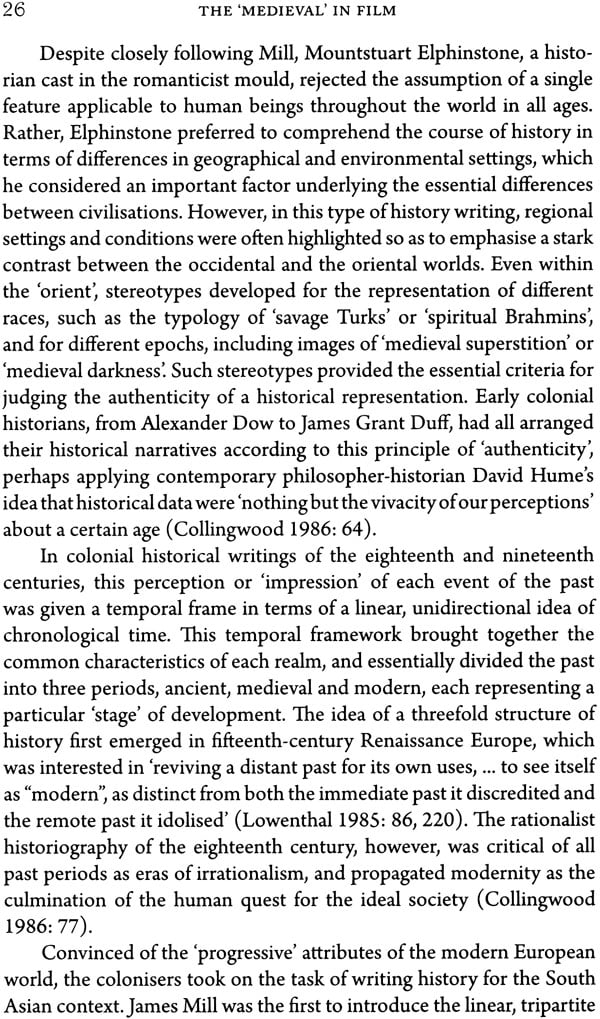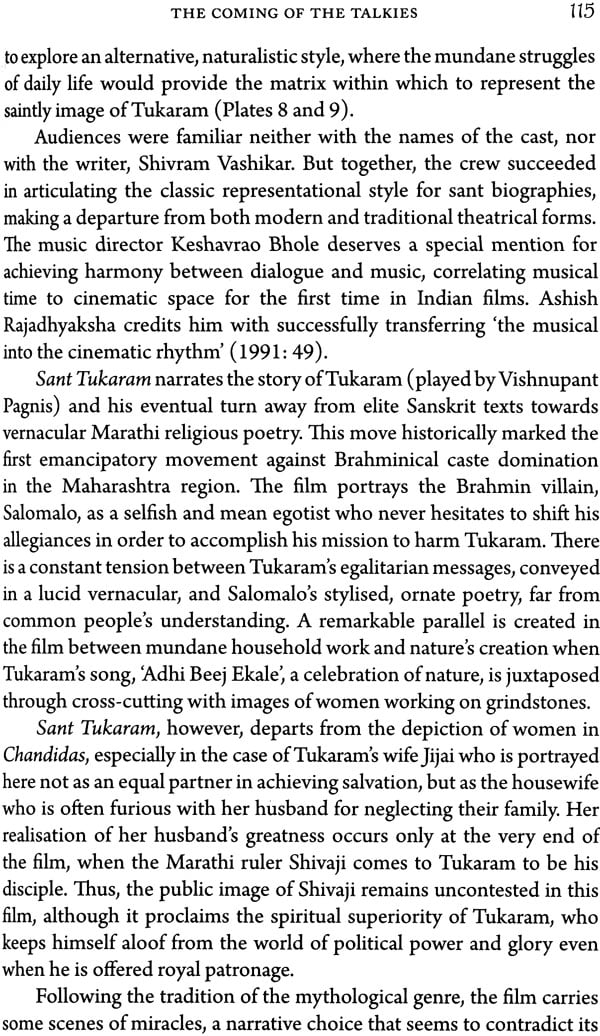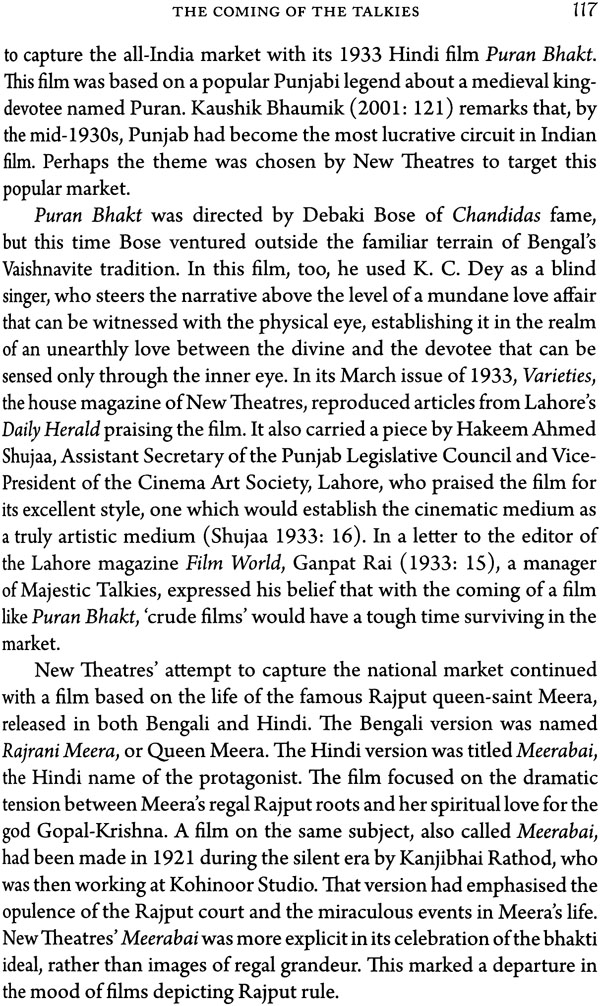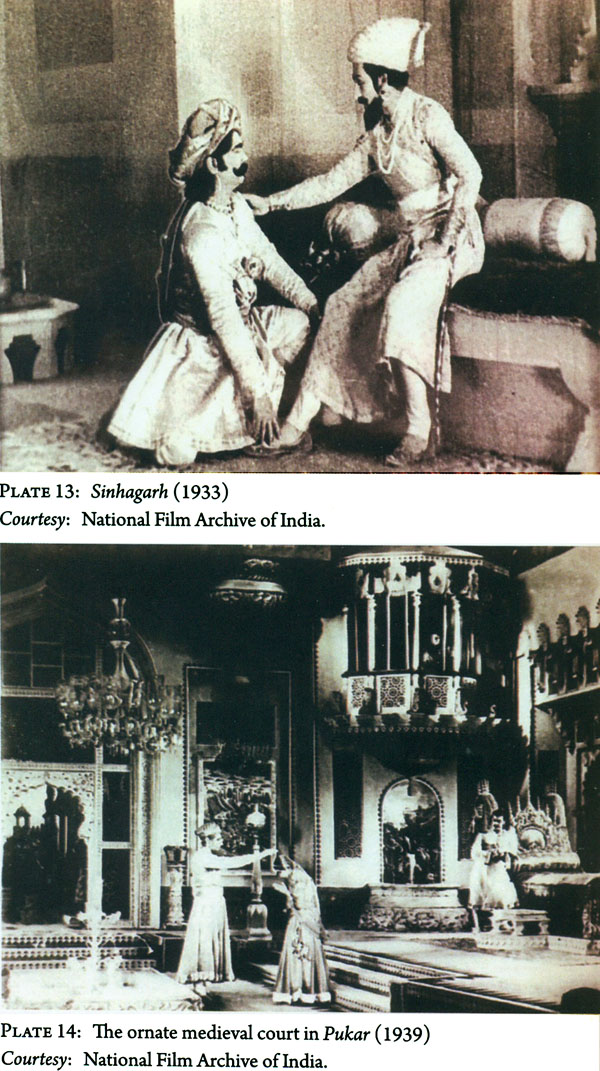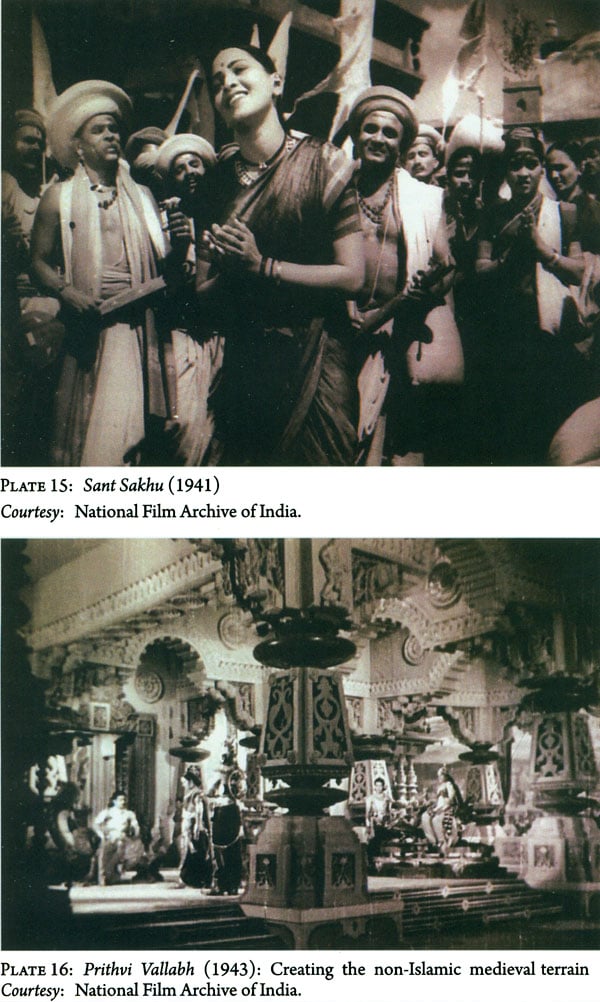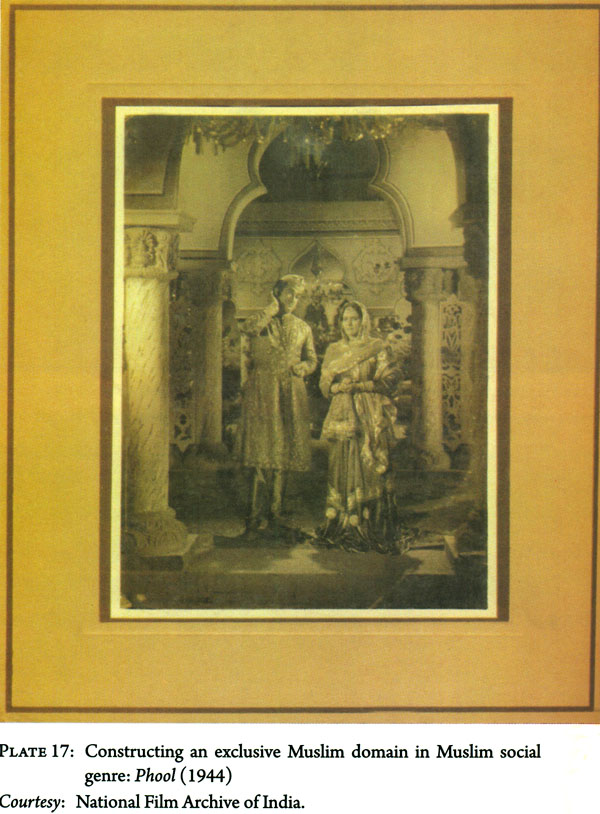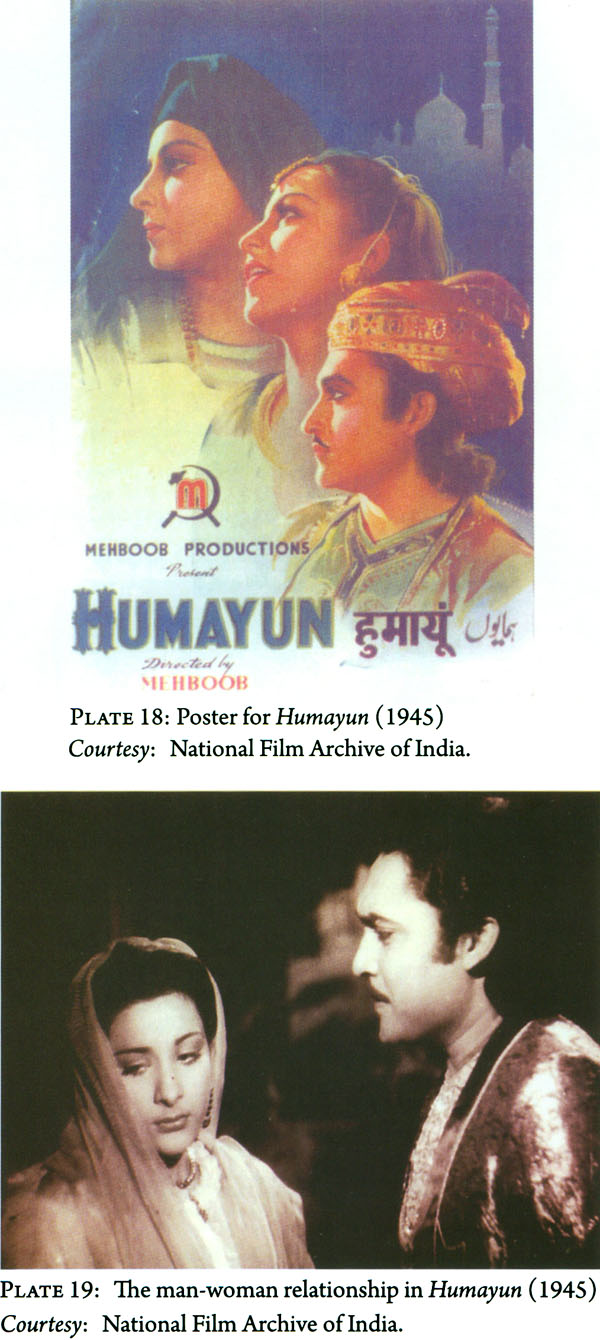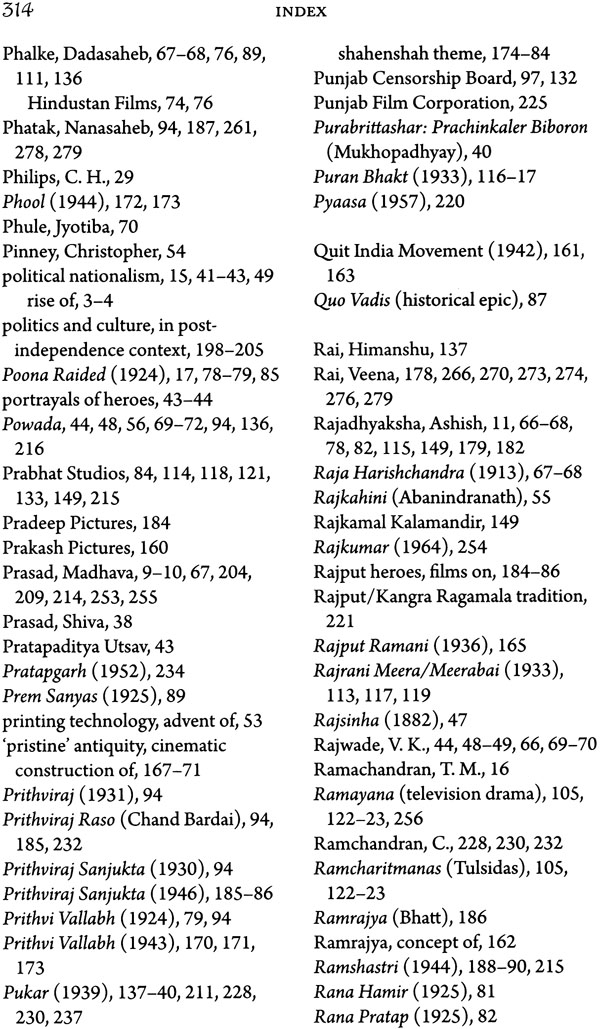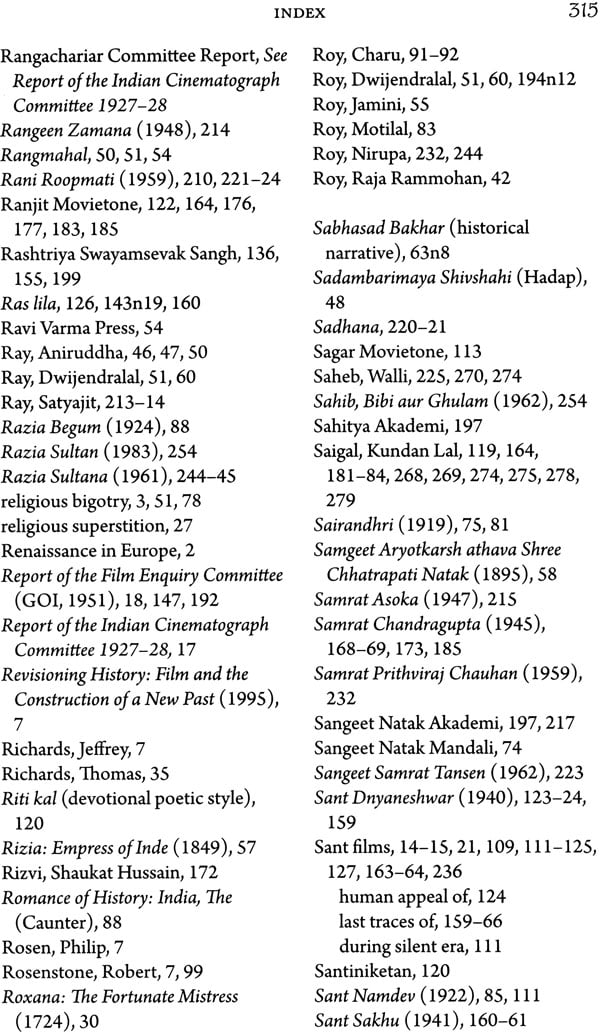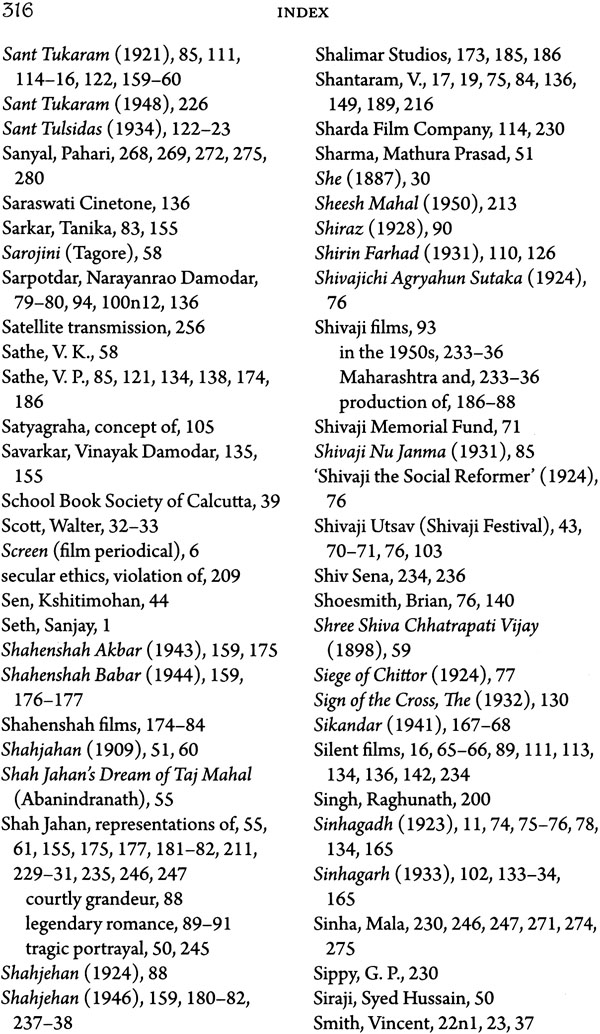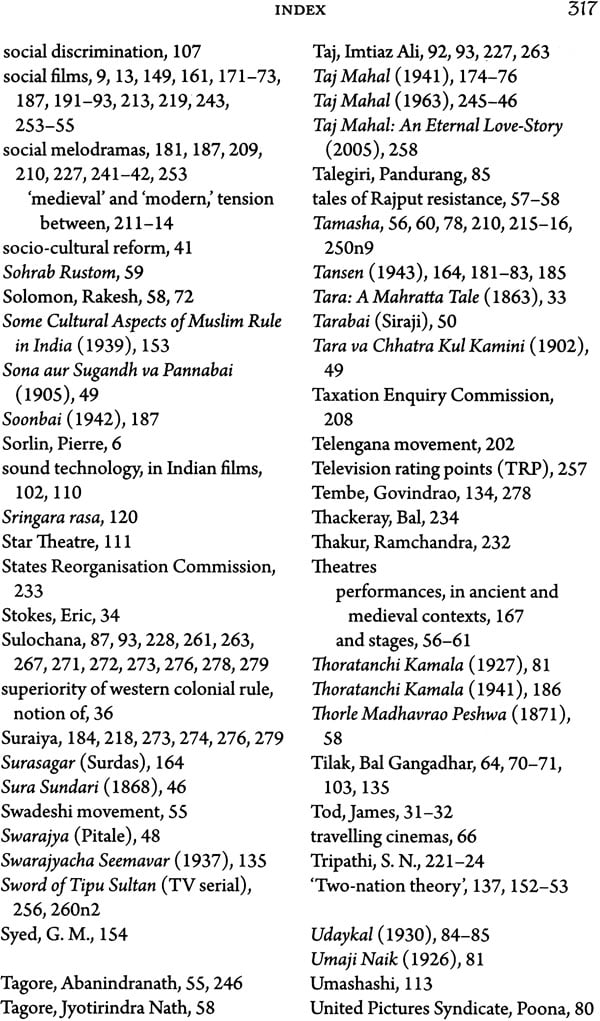
The ‘Medieval’ in Film: Representing a Contested Time on Indian Screen (1920s-1960s)
Book Specification
| Item Code: | NAH277 |
| Author: | Urvi Mukhopadhyay |
| Publisher: | Orient Blackswan Pvt. Ltd. |
| Language: | English |
| Edition: | 2013 |
| ISBN: | 9788125050988 |
| Pages: | 333 (6 Color and 15 BW Illustrations) |
| Cover: | Hardcover |
| Other Details | 9 inch X 5.5 inch |
| Weight | 550 gm |
Book Description
About the Book
Wars, nationalism, economic depression, colonisation, decolonisation and, more recently, globalisation, have affected perceptions of contemporary as well as past worlds. Cinema has reacted to and in turn shaped the changing political, social and economic conditions of the times.
This book investigates how cinema interpreted the dominant ideas of history in order to construct a range of historical imageries. Focusing on the medieval epoch-a notion of historical age as an equivalent to the European idea of Middle Ages - it studies the influences of various nationalist imaginations of the past, unmistakably present after the emergence of a mass-based nationalist movement in the 1920S and 1930S.
The ‘pre-modern’ idea of society and governance in the medieval period came under attack from the ‘modern’ colonial rulers. Also, because of its association with the Islamic ruling class it was criticised by the dominant ‘Hindu’ nationalist ethos of the time. The volume examines this contested time on screen, and raises questions like:
How did the internal organisation of the film industry guide the articulations of certain stereotypical images of the ‘medieval’ during the 1920S to 1960s? How did dominant historiographical interpretations influence a popular production like film in the colonial and the post-colonial situation? Did the cinematic representation succeed in codifying ‘medieval reality’ with stereotypes other than that of elitist vision of historicity?
With an extensive filmography and detailed bibliography, the words that populate the book are also complemented with glimpses of posters and scenes from the films discussed in the book. An important read for students and scholars of film studies, history, visual anthropology, South Asian studies and culture studies.
About the Author
Urvi Mukhopadhyay is Assistant Professor, Department of History, West Bengal State Universilt, Barasat.
Introduction
The evolution of cinema as a cultural medium is rooted in the wider society; cinema has reacted to and in turn shaped the changing political, social and economic conditions of the times. Socio-political phenomena such as wars, nationalism, economic depression, colonisation, decolonisation and, more recently, globalisation have affected perceptions of contemporary as well as of past worlds. As a popular medium generally directed at the broadest possible audience, cinema reflects and refracts these experiences by constituting their images as ‘crystals of time’ (Deleuze 1986: 190), where the present necessity of confronting the past articulates the representational process. Thus, projections of the past in a popular medium depend on the various perceptions of historical time that have prevailed in the wider, popular arena. Cinema derives its images from both academic and non-academic engagements with history.
The idea of historicism, viewed as a Significant marker of the modern historical sensibility, has an undeniable linkage with notions regarding ‘perceptions’ of the past, generally corroborated by factual data and sources. Writing in eighteenth-century Europe, David Hume, one of the most important ideologues of the rationalist school of history and the Enlightenment in general, commented that the reliability of historical data depended on ‘nothing but the vivacity of our perceptions’ of a certain age (Collingwood 1986: 64). Commenting on the practices of modern historicism, Sanjay Seth (2008: 6) sees the Weberian idea of Weltanschauung (world-picture) as an essential component of historical writings, whereby the ‘world-picture’ of a bygone age was reconstructed by putting together bits and pieces of its art, philosophy and so on. Thus, by a queer mixture of sources, or bits and pieces of the past and perceptions about the past, a ‘world-picture’ was constructed and narrated through modern historical writings.
In the face of the commercial and political patterns of market forces, some perceptions of the past dominate over others, creating multi- layered narratives. This layering is more apparent in ‘non-academic’ engagements with history or historical representations. The advent of new technologies in historical representation, particularly print and audio-visual media, has helped to re-emphasise the proximity between the present and the past, which had been somewhat pushed aside by the introduction of a critical scientific objectivity in writing disciplinary history. These popular, media-based representations have resulted, as Prachi Deshpande (2007: 3) observes, in ‘the renewed privileging of Memory as an elusive, yet more legitimate means of getting closer to the past’.
The only addition that I would make to this observation is that I prefer to use the word ‘memories’, in place of ‘Memory’, to indicate the plurality of perceptions that creates a multi-layered narrative of the historical past. In this volume, I investigate the complex socio-political and cultural matrix in which perceptions of the ‘medieval’ age in India, as revealed in cinematic representations during the period from the 1920s to the 1960s, have been rooted, with particular emphasis on representations of the medieval histories of the northern and western parts of the country.
Constructing the ‘Medieval’ Terrain-The idea of the ‘medieval’ is deeply entrenched in the periodisation of the past as it exists in academic history. Compared to the other two periods (ancient and modern) in the accepted tripartite periodisation of history projected since the Renaissance in Europe, and later on in the colonised world, the ‘medieval’ is a very recent construct. It had no parallel concept or connotation in pre-Renaissance historical consciousness, in either Europe or South Asia. In fact, pre-modern historical perceptions in India included some notions of a distant ancient and an immediate present age, but the period ‘medieval’ obviously dates from the days of colonial historiography.
It was only in 1920 that the term ‘medieval’ first came to be used to define the period between the ancient ‘Hindu’ and the modern British periods in the Indian context (Smith 1919: 2).1 Before 1920, this period was generally described as the ‘Islamic’ or ‘Muhammadan’ period of Indian history, which was seen as marked by instability, misrule, invasion and social turmoil. These features resembled those of the ‘Dark’ or ‘Middle’ Ages, as perceived by European historians of the Enlightenment. In both colonial and later nationalist perspectives, this period was identified with a despotic imperial political system, where religious bigotry, courtly intrigues, superstitions, socio-political restlessness and foreign domination prevailed. These criticisms analogised the medieval ‘Islamic’ age to the European medieval ‘Dark Ages’ in written historiographies (Hasan 1996: 198).
Whatever the initial engagement of the western-educated academia with this period, the ‘medieval’ or the ‘Islamic’ /’Muslim’ age soon became the locale of larger historical and political debates with the rise of political nationalism in the Indian subcontinent, especially after the 1870s. Partly as a result of colonial writings, which stressed the ‘foreign’ origin of the Islamic rulers of India, the medieval state with its elaborate taxation network and administrative hierarchy came to be regarded as parasitical in the subcontinent, and was likened to contemporary colonial rule in nationalist-particularly Hindu nationalist-rhetoric. The ‘foreignness’ attributed to medieval Islamic rulers gave nationalists an opportunity to interpret anti-Mughal struggles as pre-colonial anticipations of the nationalist upsurge.
On the other hand, in spite of this ‘foreignness’, the Mughal state with its complex administrative and fiscal systems provided the closest parallel to the contemporary colonial system. This conveniently enabled nationalists during the second half of the nineteenth century to establish their claims of a pre-colonial, non-British legacy of the state system. In fact, the attempt to build the consciousness of a nation-state (often termed ‘political nationalism’) made the nationalists shift their attention from the distant, ancient ‘Hindu’ culture to the comparatively recent ‘Islamic’ medieval state. Although in nationalist rhetoric this period was seldom interpreted in a favourable light, its invocation became central to the nationalist debate.
Political nationalism also came to realise the importance of mass mobilisation in achieving its goals. The radical transformation in the organisation of nationalist politics brought this rhetoric to a wider social arena, where its prerogatives as well as its historical invocations were opened up for the scrutiny and understanding of the general public. In the changed circumstances, these historical invocations were packaged in more easily recognisable forms, such as stories, novels and theatre. Thus, nationalist culture adopted the ‘historical’ as a form or a genre to convey to the masses its version of Indian history.
These ‘historicals, however, were hardly the preserve of elite interests. As a popular genre, they represented a multivalent understanding of the past, where nationalist invocations rooted in the western, elitist understanding of ‘objective history’ met with non- academic engagements with the past stored as memory and experience (Laine 2003: 63-88). The relationship between these ‘academic’ and ‘non-academic’ impressions of the past became increasingly complex as representational forms moved away from elite and literate cultural enclaves. For instance, while historical novels which catered to a literate section of society, generally conformed to the historical details of history writing proper, cinematic representations of the past showed no such fidelity. Primarily directed at non-academic, non- elite audiences, they accommodated a far wider variety of images and representations rooted in popular memory that found no place in elite historical discourses.
Filmic representations of the past are significant in the context of the recent debates around elite and subaltern consciousness and the question of agency in interpreting historical experience (Nandy 1998a: 6-7). The postmodernist challenge to the traditional notion of historicity often identifies the disjunctive elements in popular historical representations as expressions of a ‘primordial’ sense of the past, undisturbed by the grand narrative of modern, elite historicism (ibid.. 13). While this volume will not participate in this debate, it seeks to understand how, despite the dominance of elite historiography and the inevitable transformation of ‘‘popular’ consciousness, a market-oriented medium like film, when articulating its historical visions, adds another dimension to the already complex socio-cultural process of looking at the past.
Film and History/History in Film-Current debates around issues of popular representations and their agency in interpreting the past underscore the importance of Antonio Gramsci’s work on the role of mass and popular culture. According to Gramsci, all such perceptions of the past are accommodated to produce consensus and hegemony. Parallel to current work in postmodernist and poststructuralist theories, Gramsci’s writings, as Landy argues, ‘challenge monolithic notions of ideology, offering instead more nuanced and multivalent critical tools for understanding and appropriations of the past’ (Landy 1996: 3). Investigating the cultural foundations of both the Risorgimento and of fascism in Italian history, Gramsci sought to understand how established ruling groups consolidated their power in the name of national unification and populism, thwarting change through consensus and the absorption of more radical groups. This interpretation throws light on the strategies of accommodation of numerous perspectives and interests, which, despite their inner contradictions, are made to appear harmonious. Interestingly, this means that historical representations, particularly those in the popular media, often appear to mimic the dominant interpretation of the time. Closer scrutiny, however, reveals the fragmentary nature of these narratives, which refract subaltern perspectives in historical knowledge.
Cinematic narratives that address the issues and contexts of the past can be analysed in a similar light. Geoffrey Nowell-Smith (1990: 160) argues that a cinematic text can be used as a source of history, because it is ‘embedded deep into what one might call the external histories of the century-those of economics and politics for example-s-but even more deeply into the history of modern subjectivity: This centrality of subjectivity in representing history exemplifies the controversies around the issue of representation, and pushes the boundaries of analysis beyond the traditional attitude emphasising empirical truth and objectivity as the only criteria for judging historical ‘authenticity’. Rather, this analytical rationale situates strategies of representing thepast in the broader context of the immediate present that occasions varied interpretations of past events.
As early as the 1970s, Mark Nash and Steve Neale emphasised the need to perceive cinema as a social institution, and history as a set of discursive practices (Nash and Neale 1977-78: 77). For them, the term ‘institution’ means not only a location of social practice, but also a system of standards for production, distribution and reception that produces and reproduces ideology, hence ‘defining subjective as well as inter-subjective positions’ (Murray 1992: 3). Further, according to Nash and Neale, ‘history ... is neither the past as such, nor yet a discourse in which the past is revealed, but rather a set of discourses in which the past is constructed’ (Nash and Neale 1977-78: 77).
From this perspective, the filmic use of the past opens up some new areas of investigation that are pertinent to historical studies. For example, the narrative strategies of historical films and their contribution in identifying the past for spectators ultimately interrogate the temporality of historicism or historical ideas in a society (Rosen 2001: 12). The question becomes why, how and under what circumstances certain impressions of the past project a ‘historical milieu’ that is perceived by a large section of the population as acceptable and authentic. Marc Ferro (1988: 30) thus perceives film as both a source and an agent off in history. According to Ferro, understanding film as a historical source involves understanding ‘its relationships with the societies that produce and consume it’-in other words, grasping how the filmic narrative reflects the social interests involved in its making. On the other hand, Ferro argues, in its representation and promotion of specific values and attitudes in a particular culture, the filmic medium acts like an agent of history (Ferro 1983: 358).
Contents
| List of Plates | ix | |
| Acknowledgements | xi | |
| Introduction | ||
| Film and the ‘Medieval’/the ‘Medieval’ in Film | ||
| 1 | The Construction of a ‘Medieval’ Past and Its Uses in Colonial India | 23 |
| 2 | ‘Re-visioning’ the Medieval Past (The Silent Era of Indian Film) | 64 |
| 3 | ‘Re-visioning’ the Medieval Past (The Coming of the Talkies) | 102 |
| 4 | The ‘Medieval’ in a Time of Communal Polarisation, 1940-46 | 145 |
| 5 | Contesting Visions of the ‘Medieval’ in Independent India, 1947 to the 1960s | 196 |
| Conclusion | 252 | |
| The ‘Medieval’ in Post-Nehruvian India | ||
| Filmography | 261 | |
| Bibliography | 281 | |
| Index | 303 |



